In June 1950 the North Korean Army crossed the 38th parallel, invading the Republic of South Korea. By September, most of the Republic had fallen, with only the area around the city of Busan, or Pusan as it was then known in English, remaining under the control of anti-Communist forces. As the Republic collapsed, half a million refugees fled south to the coastal city, swelling the population to around 1.4 million. The Battle of Pusan Perimeter raged, and conditions within the titular city were equally chaotic.
The Bosudong area of Busan became home to a significant number of refugees who had fled the Nothern advance. One displaced couple began selling old magazines from the U.S. military, and this quickly expanded in scope as the impoverished sold or pawned their books. Even as the war continued into 1951, seventy percent of children in Busan still attended primary school, even if classes were held in the open air. The proximity of many such 'provisional schools' in Bosudong ensured the growth of the second-hand book market, and the number of shops grew until by the 1960s there were around seventy crammed together in the narrow 'Bosudong Book Street' ('보수동 책방 골목'). The speed of the North Korean advance during the war had separated many families and friends, and the 'Book Street' also became a place for refugees to meet, socialise and perhaps search for those they had lost, long after hostilities had ended.
Today, sixty years after the war began, 'Bosudong Book Street' still exists and has become part of Busan's cultural heritage, and there is also, perhaps inevitably, an annual festival.
The street is not really a street at all for most of its length, but rather a narrow passageway with book shops of various shapes and sizes on both sides. In itself, this might create a rather disorganised feeling, but the effect is only heightened by the contents of the stores, many of which feature chaotic stacks of books placed everywhere there is a space. Often this spills out into the 'street' itself, only serving to make it even narrower. Along with the tarpaulins over the front of the shops to protect the books from the elements, it combines to create a somewhat claustrophobic atmosphere.
Inside the shops, the chaotic theme continues, with careful navigation a priority, and an acceptance that this may not be a place for the tall - even I had to duck under a large beam to reach one part of the upper floor of one particular store.
Most books were Korean, but not all of them. I was surprised to find one shop filled with old books in English, most of the titles and authors of which must surely have been long forgotten in the West. An ageing and probably unloved tribute to Western circa-1970s pulp fiction.
In addition to the decorative sewer grates which never detract from the emerging stench but are a regular feature of Busan's cultural districts, the street itself features tributes to the great works of literature such as Around the World in 80 Days by Jules Verne and Crime and Punishment by Dostoevsky.
We'd planned on visiting 'Bosudong Book Street' for a number of weeks, but the night before the local news did a piece on an photo exhibition about the street that was being held until the weekend, so we expected that the publicity might result in the street being busy. In fact it wasn't busy at all, which was both surprising and a little saddening. It seems that in recent years, the character of the street has begun to change, as economic prosperity created more demand for new books. And while second-hand books can still be found in abundance, one suspects that the chaos of the second-hand book market is slowly giving way to a more ordered and modern consumer experience. As much as poverty created this place, wealth may be changing it fundamentally.
The black and white photos featuring the owners of the remaining Book Street stores looked out over an empty space at the Bosudong Catholic Exhibition Center.
The Bosudong area of Busan became home to a significant number of refugees who had fled the Nothern advance. One displaced couple began selling old magazines from the U.S. military, and this quickly expanded in scope as the impoverished sold or pawned their books. Even as the war continued into 1951, seventy percent of children in Busan still attended primary school, even if classes were held in the open air. The proximity of many such 'provisional schools' in Bosudong ensured the growth of the second-hand book market, and the number of shops grew until by the 1960s there were around seventy crammed together in the narrow 'Bosudong Book Street' ('보수동 책방 골목'). The speed of the North Korean advance during the war had separated many families and friends, and the 'Book Street' also became a place for refugees to meet, socialise and perhaps search for those they had lost, long after hostilities had ended.
Today, sixty years after the war began, 'Bosudong Book Street' still exists and has become part of Busan's cultural heritage, and there is also, perhaps inevitably, an annual festival.
The street is not really a street at all for most of its length, but rather a narrow passageway with book shops of various shapes and sizes on both sides. In itself, this might create a rather disorganised feeling, but the effect is only heightened by the contents of the stores, many of which feature chaotic stacks of books placed everywhere there is a space. Often this spills out into the 'street' itself, only serving to make it even narrower. Along with the tarpaulins over the front of the shops to protect the books from the elements, it combines to create a somewhat claustrophobic atmosphere.
Inside the shops, the chaotic theme continues, with careful navigation a priority, and an acceptance that this may not be a place for the tall - even I had to duck under a large beam to reach one part of the upper floor of one particular store.
Most books were Korean, but not all of them. I was surprised to find one shop filled with old books in English, most of the titles and authors of which must surely have been long forgotten in the West. An ageing and probably unloved tribute to Western circa-1970s pulp fiction.
In addition to the decorative sewer grates which never detract from the emerging stench but are a regular feature of Busan's cultural districts, the street itself features tributes to the great works of literature such as Around the World in 80 Days by Jules Verne and Crime and Punishment by Dostoevsky.
We'd planned on visiting 'Bosudong Book Street' for a number of weeks, but the night before the local news did a piece on an photo exhibition about the street that was being held until the weekend, so we expected that the publicity might result in the street being busy. In fact it wasn't busy at all, which was both surprising and a little saddening. It seems that in recent years, the character of the street has begun to change, as economic prosperity created more demand for new books. And while second-hand books can still be found in abundance, one suspects that the chaos of the second-hand book market is slowly giving way to a more ordered and modern consumer experience. As much as poverty created this place, wealth may be changing it fundamentally.
The black and white photos featuring the owners of the remaining Book Street stores looked out over an empty space at the Bosudong Catholic Exhibition Center.
—
Busanmike.blogspot.com
Twitter: @BusanMike
YouTube: /BusanMikeVideo
Flickr: /busanmike


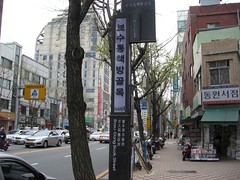
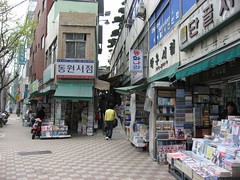
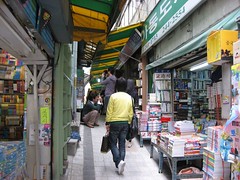
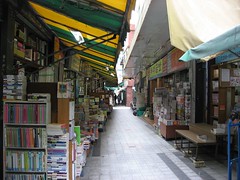

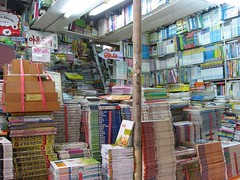


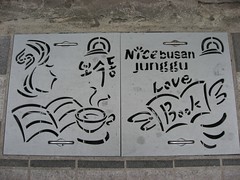
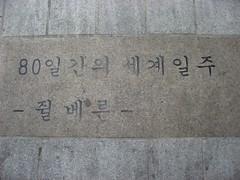

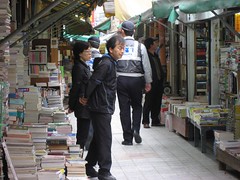

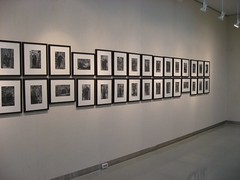
Recent comments